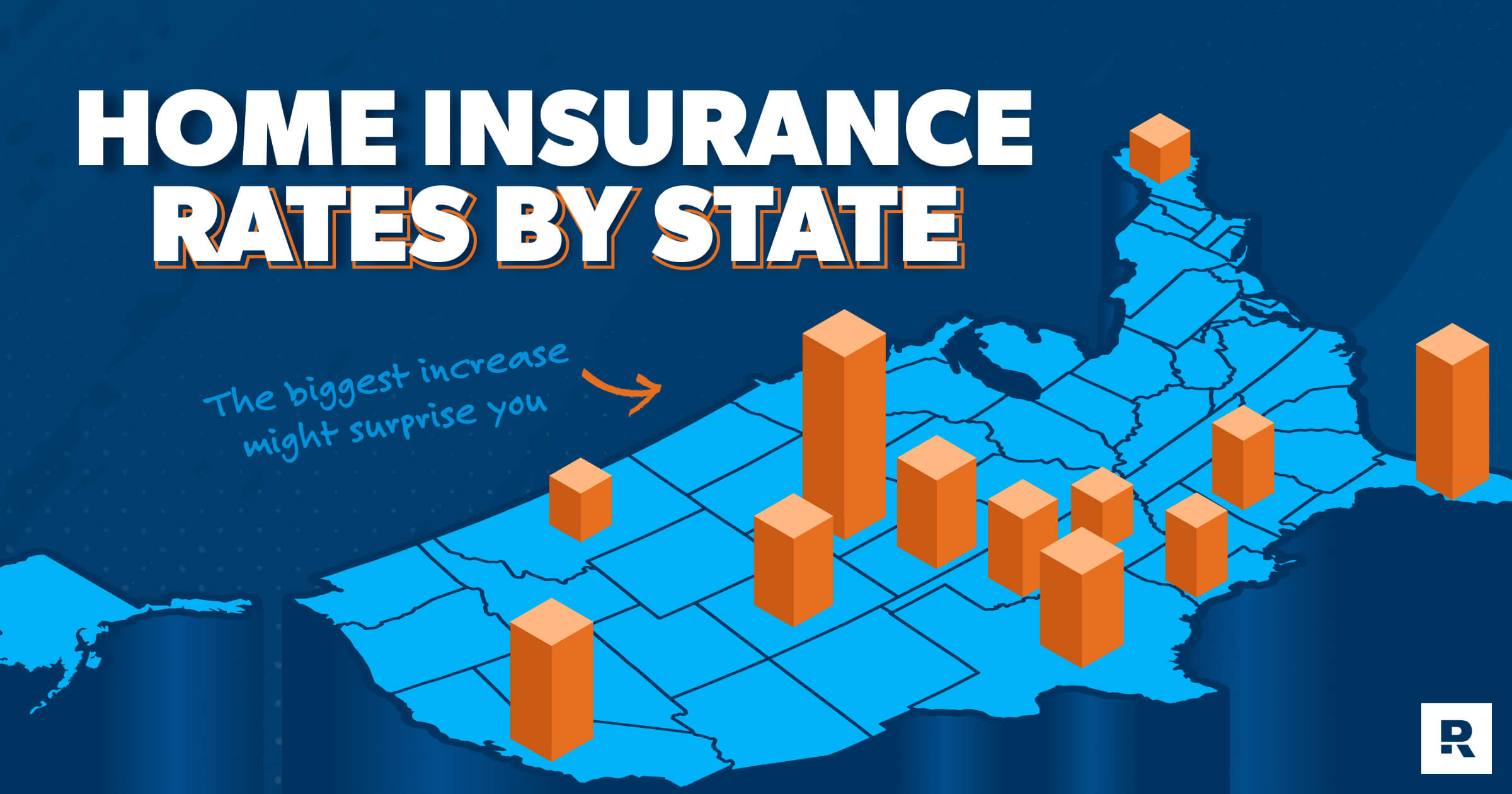Home Insurance Rates by State for 2025
8 Min Read | Apr 9, 2025

Rising insurance rates are squeezing a whole lot of wallets these days. And some of that pressure is coming from the cost of home insurance. Homeowners are understandably asking, “Why has my coverage has gotten so expensive?” The answer is complex, and at least part of the picture has to do with the state you live in. We’ll look at how rates are shaking out in each state in 2025.
But before we dive in, here are a couple things to keep in mind:
- No matter how high rates rise, you can take specific steps to fit insurance into your budget. (We’ll cover them a little later.)
- That’s good news because you simply can’t go without home insurance—we’re talking about protecting your biggest investment here!
All right, let’s find out where home insurance is the most expensive and where it won’t break the bank.
State-by-State Breakdown of Home Insurance Costs
Across America, several factors are driving home insurance rates up, including supply chain bottlenecks, third-party lawsuits against insurers, and a big increase in extreme weather events.1 In 2024, all that trouble hit at once—in some states harder than others. But even in the chaos, other states trended well below the national average.
Top 5 States With the Highest Average Home Insurance Premiums in 2025
And the award for priciest home insurance in 2025 goes to . . . Nebraska! Yeah, that’s not exactly an honor they were competing for. But it’s also not a reason to move out of state. (Remember, we’ll give you some tips below on how to save on home insurance.)
In some of the most expensive states, natural disasters (think tornadoes and hurricanes) are driving prices up and up. In 2024, Nebraska recorded its highest number of tornadoes in 20 years, suffering $15 million in property damage.2 Florida and Louisiana also suffered more than their fair share of hurricanes last year, even in a region famous for its stormy weather.
Those extreme events brought on boatloads of homeowners insurance claims. And yes, the number of claims in your area does impact your (and your neighbors’) premiums going forward.
These are the top five states with the highest average home insurance annual premiums:
- Nebraska: $5,640
- Florida: $5,488
- Oklahoma: $4,643
- Kansas: $4,287
- Louisiana: $4,135
Data from Quadrant Information Services. Rates are accurate as of February 2025.
Top 5 States With the Lowest Average Home Insurance Premiums in 2025
Who got the bragging rights for cheapest rates this year? Your winner is Vermont!
As the state with the second-lowest population (which means fewer homes), it’s maybe not too surprising that home insurance rates are so affordable there.3 And unlike those extreme-weather hot spots above, property damage from tornadoes and hurricanes is pretty rare in Vermont.
The same goes for the rest of the top five states with the lowest average annual premium:
- Vermont: $830
- Alaska: $933
- Delaware: $964
- West Virginia: $1,009
- Oregon: $1,011
Data from Quadrant Information Services. Rates are accurate as of February 2025.
Compare Homeowners Insurance Rates by State
The national average premium for homeowners insurance is $2,258 per year ($188 monthly) for $300,000 of dwelling coverage. But that number varies a whole lot from state to state. Sure, some are worse—but some are a whole lot better.
The state you live in isn’t the only factor in how insurance companies set your home insurance rate, but it does play a role. This chart shows the average homeowners insurance premiums by state for $300,000 in dwelling coverage.
Average Homeowners Insurance Premiums by State in 2025
|
State |
Average Yearly Premium |
Average Monthly Premium |
Difference From National Average Yearly Premium |
|
Alabama |
$2,989 |
$249 |
+$732 |
|
Alaska |
$933 |
$78 |
-$1,325 |
|
Arizona |
$2,245 |
$187 |
-$13 |
|
Arkansas |
$3,151 |
$263 |
+$893 |
|
California |
$1,429 |
$119 |
-$829 |
|
Colorado |
$3,167 |
$264 |
+$910 |
|
Connecticut |
$1,660 |
$138 |
-$598 |
|
Delaware |
$964 |
$80 |
-$1,293 |
|
Florida |
$5,488 |
$457 |
+$3,231 |
|
Georgia |
$1,994 |
$166 |
-$264 |
|
Hawaii |
$1,224 |
$102 |
-$1,034 |
|
Idaho |
$1,293 |
$108 |
-$965 |
|
Illinois |
$2,265 |
$189 |
+7 |
|
Indiana |
$1,712 |
$143 |
-$545 |
|
Iowa |
$2,197 |
$183 |
-$61 |
|
Kansas |
$4,287 |
$357 |
+$2,029 |
|
Kentucky |
$3,354 |
$280 |
+$1,097 |
|
Louisiana |
$4,135 |
$345 |
+$1,877 |
|
Maine |
$1,243 |
$104 |
-$1,015 |
|
Maryland |
$1,671 |
$139 |
-$587 |
|
Massachusetts |
$1,703 |
$142 |
-$555 |
|
Michigan |
$2,117 |
$176 |
-$141 |
|
Minnesota |
$2,628 |
$219 |
+$371 |
|
Mississippi |
$3,339 |
$278 |
+$1,081 |
|
Missouri |
$2,302 |
$192 |
+44 |
|
Montana |
$2,511 |
$209 |
+$254 |
|
Nebraska |
$5,640 |
$470 |
+$3,382 |
|
Nevada |
$1,031 |
$86 |
-$1,227 |
|
New Hampshire |
$1,026 |
$86 |
-$1,232 |
|
New Jersey |
$1,194 |
$100 |
-$1,063 |
|
New Mexico |
$2,205 |
$184 |
-$52 |
|
New York |
$1,752 |
$146 |
-$506 |
|
North Carolina |
$2,055 |
$171 |
-$202 |
|
North Dakota |
$2,709 |
$226 |
+$451 |
|
Ohio |
$1,303 |
$109 |
-$954 |
|
Oklahoma |
$4,643 |
$387 |
+$2,386 |
|
Oregon |
$1,011 |
$84 |
-$1,247 |
|
Pennsylvania |
$1,245 |
$104 |
-$1,013 |
|
Rhode Island |
$2,324 |
$194 |
+$66 |
|
South Carolina |
$2,374 |
$198 |
+$117 |
|
South Dakota |
$3,049 |
$254 |
+$791 |
|
Tennessee |
$2,499 |
$208 |
+$241 |
|
Texas |
$3,973 |
$331 |
+$1,715 |
|
Utah |
$1,262 |
$105 |
-$995 |
|
Vermont |
$830 |
$69 |
-$1,428 |
|
Virginia |
$1,664 |
$139 |
-$594 |
|
Washington |
$1,513 |
$126 |
-$745 |
|
West Virginia |
$1,009 |
$84 |
-$1,248 |
|
Wisconsin |
$1,219 |
$102 |
-$1,038 |
|
Wyoming |
$1,306 |
$109 |
-$952 |
Data from Quadrant Information Services. Rates are accurate as of February 2025.
Protect your home and your budget with the right coverage!
Factors in Your Home Insurance Cost
How are rates looking in your home state? As you can see, there are plenty of states trending well below that high national average.
But even if you’re not in one of those states with lower premiums, no need to panic—and for sure, no need to sell and move just to save on homeowners insurance. We’ve got ideas for you to lower your premium that don’t involve job searches or moving trucks.
Here are the main factors insurers use to set your home insurance premium, along with ideas about how you can adjust each factor to bring that premium down:
Replacement Cost
Your replacement cost means the dollar amount insurers guess would be needed to replace your home in the event of damage. You can’t do much to bring this cost down—other than moving into a smaller place with cheaper furniture. Then again, if the cost of home insurance is keeping you from making financial progress, downsizing might make a lot of sense (and would probably help you save in a lot of other ways at the same time).
Location
This is the main factor we’ve already been talking about. High insurance cost probably isn’t the leading reason anyone chooses to relocate. But if you live in Nebraska and happen to make an online love connection in Vermont, lower premiums (and higher oxytocin) could be in your future.
Age and Condition of Your Home
Older homes or those with known issues will have higher premiums. That’s logical, right? And while a time machine might come in handy here, the age of your home is pretty much one of those factors you have no control over. On the other hand, you can improve its condition. First, general maintenance will make your life easier and head off future claims. Then, some insurers will give you a break on premiums for installing extra safety features like burglar alarms, smoke detectors or dead bolt locks.
Level of Coverage and Deductible
Some of your premium is based on your amount of coverage and how large your deductible is. (Your deductible is the amount you’ll pay out of pocket for a homeowners claim before the insurance company starts covering the costs.) If you have the emergency fund to cover it, a higher deductible is a smart way to lower your premiums.
Construction Type
Obviously, you can’t wave a wand to change this for your current home. But if you are thinking of moving, keep construction type in mind as you shop. Wood homes have higher premiums, while insurance for brick and concrete structures is more affordable.
Your History of Claims
Past claims come into play with your premium too. It might feel unfair, but it’s one of the facts of the insurance game. In fact, a high number of claims in your neighborhood affects everyone’s premiums! So the next time your child fires a wayward boomerang through your living room window, think about paying to fix it yourself. The effort will probably help keep your premium down (while a claim could circle back and bite you).
Size of the House
We know this might sound like yet another “that’s out of my control” factor. But it’s worth knowing how much more you’d be paying if your house was twice its current size—or how much you could save by downsizing.
Number of Occupants
The more people under your roof, the higher the probability of accidents and claims. The only way to shrink this number is to shoo your children into homes of their own when they become adults (while being sure to share this article with them).
More Ways to Save on Homeowners Insurance
Still not satisfied you’ve done everything possible to bring down that home insurance premium? We have a couple more tips for you.
First, shop with an independent agent. We recommend working with one of our RamseyTrusted® local pros. They’re experts who know the insurance industry inside and out, with the experience to understand what’s driving rates in your area. They’ll have plenty of ideas to help you save.
And second, while you’ve got that RamseyTrusted pro on the phone, be sure to ask about the possibility of saving through bundling. It doesn’t apply in every situation, but in many cases, combining your homeowners insurance with another policy is another way to save on premiums.
Next Steps
- Figure out how much home insurance you need.
- Find out if you need any extra insurance, like flood insurance, hurricane insurance or earthquake insurance.
- If you already have homeowners insurance, shop around and see if changing carriers or deductibles can save you money.
- Estimate how much you’ll need to pay.
- Get in touch with a RamseyTrusted insurance pro who can do the heavy lifting for you (like looking into bundling options) and help you figure out the right coverage for you.



